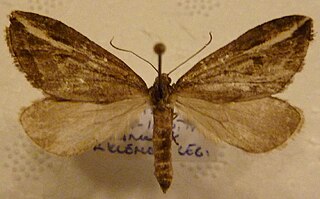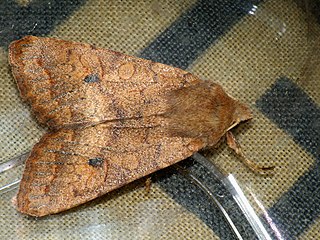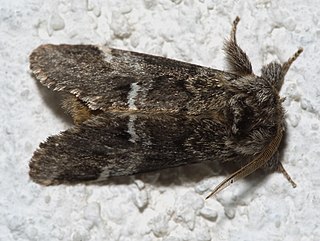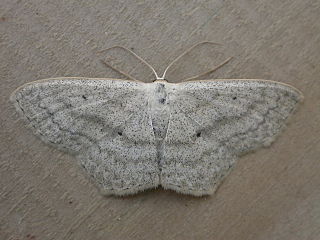
The streak is a moth of the family Geometridae. It is found in northern and western Europe and north Africa. It is common in Britain, but local and confined to the north in Ireland. The species was first described by Michael Denis and Ignaz Schiffermüller in 1775.

The common footman is a moth of the family Erebidae. The species was first described by Johann Leopold Theodor Friedrich Zincken in 1817. It is distributed throughout Europe and east through the Palearctic to Lake Baikal.

The buff-tip is a moth of the family Notodontidae. It is found throughout Europe and in Asia to eastern Siberia. The species was first described by Carl Linnaeus in his 1758 10th edition of Systema Naturae.

Agrochola circellaris, or The Brick, is a species of moth of the family Noctuidae. The species was first described by Johann Siegfried Hufnagel in 1766. It is distributed throughout most of Europe, Asia Minor and Armenia.

The poplar grey is a moth of the family Noctuidae. It is found throughout Europe.

Cerura vinula, the puss moth, is a lepidopteran from the family Notodontidae. The species was first described by Carl Linnaeus in his 1758 10th edition of Systema Naturae.

Furcula furcula, the sallow kitten, is a moth from the family Notodontidae. It was first described by the Swedish entomologist Carl Alexander Clerck in 1759 from a specimen found in Sweden.

Leucodonta bicoloria, the white prominent, is a moth from the family Notodontidae. It ranges from Western Europe (Ireland) to Hokkaido (Japan) being found in the northern part of Middle Europe, Northern Europe and Russia to the Amur region. In the western parts of the range it is a local and rare species. It is likely extirpated in Britain but a population was recently rediscovered in Ireland. The habitat requirements of the species are a bit unusual, it seems to prefer locally warm deciduous and mixed forests, where birch, the sole host plant, forms the canopy. The moth survives winter as a pupa underground.

Agrochola lota, the red-line Quaker, is a moth of the family Noctuidae. The species was first described by Carl Alexander Clerck in 1759. It is distributed throughout the whole of Europe except Scandinavia; in Armenia, Asia Minor, and east across the Palearctic to the Altai Mountains and western Siberia.It was introduced to Newfoundland. In the Alps, it rises at altitudes of just over 1500 metres.

Miltochrista miniata, the rosy footman, is a moth of the family Erebidae. The species was first described by Johann Reinhold Forster in 1771. It is found in the temperate parts of the Palearctic realm – Europe, Asia Minor, Caucasus, northern Kazakhstan, southern Siberia, Amur, Primorye, Sakhalin, southern Kuriles, Heilongjiang, Liaoning, Hebei, Inner Mongolia, Shanxi, Sichuan, Korea and Japan, but may be replaced by Miltochrista rosaria in the eastern Palearctic.

Drymonia dodonaea, the marbled brown, is a moth of the family Notodontidae. The species was first described by Michael Denis and Ignaz Schiffermüller in 1775. It is found in Europe and in the area surrounding the Caucasus.

Notodonta dromedarius, the iron prominent, is a moth of the family Notodontidae. The species was first described by Carl Linnaeus in 1767. It is found in Europe and Anatolia.

Notodonta ziczac, the pebble prominent, is a moth of the family Notodontidae. It is found in Europe ranging to Central Asia.

Minucia lunaris, the lunar double-stripe or brown underwing, is a species of moth in the family Erebidae. The species was first described by Michael Denis and Ignaz Schiffermüller in 1775 and is found in Asia, Europe and North Africa.

Catocala electa, the rosy underwing, is a moth of the family Erebidae. The species was first described by Karl Friedrich Vieweg in 1790. It can be found in Europe and Asia.

Scopula nigropunctata, the sub-angled wave, is a moth of the family Geometridae. It is found through most of the Palearctic realm.

Dicallomera fascelina, the dark tussock, is a moth in the family Erebidae. The species was first described by Carl Linnaeus in his 1758 10th edition of Systema Naturae. It is found in most of Europe, through the Palearctic to Central Asia to Korea.

Odontosia carmelita, the scarce prominent, is a moth of the family Notodontidae. The species was first described by Eugenius Johann Christoph Esper in 1798. It is found in central Europe, ranging to Ireland and Finland in the north and Russia in the east.

Meganephria bimaculosa, the double-spot brocade, is a species of moth of the family Noctuidae. It is found in most of Europe, in Turkey and the west of Iran. In Anatolia it is represented by the subspecies Meganephria bimaculosa pontica.

Heterocrossa gonosemana is a species of moth in the family Carposinidae. It is endemic to New Zealand and is found throughout the country. It inhabits native forest. Larvae feed on seeds and fruit of Griselinia lucida and possibly Griselinia littoralis. They can be extremely active when disturbed. This species overwinters as a pupa, enclosed in a cocoon, underneath its host plant. Adults are on the wing from November until February and can be found during the day resting on lichen covered tree trunks where they are well camouflaged. The adult is nocturnal and is attracted to light.
























